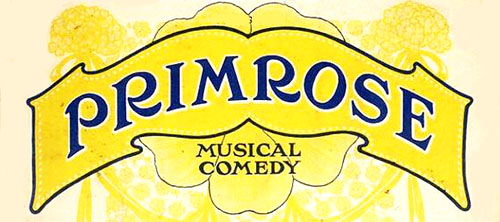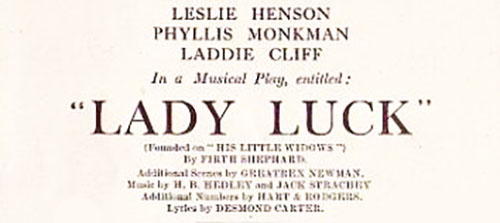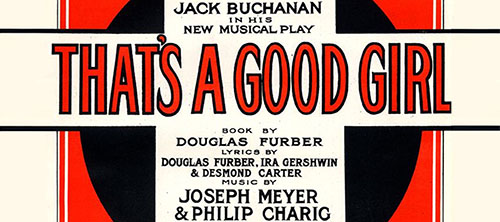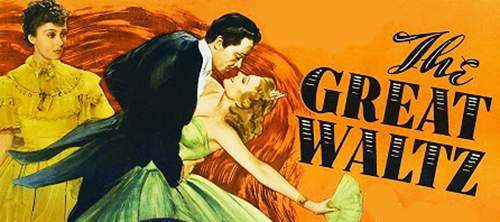Pas de biographie disponible.
Compositeur Musique additionelle Librettiste Parolier Metteur en scène Chorégraphe Producteur création Producteur version

Musical
Musique: George Gershwin • Paroles: Desmond Carter • Ira Gershwin • Livret: George Grossmith • Guy Bolton • Production originale: 1 version mentionnée
Dispo: Résumé Génèse Liste chansons
Primrose is a musical in three acts with a book by Guy Bolton and George Grossmith Jr., lyrics by Desmond Carter and Ira Gershwin, and music by George Gershwin. It centers on a writer whose story-within-a-story forms the basis of the plot. It was written expressly for the London stage, where it ran for 255 performances in 1924 and 1925. George Gershwin, at 25 years old, was an established songwriter by 1924 when Grossmith and his producing partners, J. A. E. Malone and Edward Laurillard, hired him to produce the score for Primrose for them in London. The musical is the first in which Gershwin wrote some of the orchestrations himself. The year was one of the busiest for Gershwin, as it also included his Rhapsody in Blue and two other musicals. Gershwin's score, and the book by Bolton are old-fashioned for their time, with more in common with the frothy Edwardian musical comedies than with the later Gershwin musicals.
Genèse: Primrose was produced by Grossmith and J. A. E. Malone, who wanted to follow up on their earlier successes composed by Jerome Kern.[2] It opened at the Winter Garden Theatre in London on 11 September 1924 only two months before the Gershwins’ Lady, Be Good! debuted on Broadway. The cast featured comedian Leslie Henson and also included Claude Hulbert, Heather Thatcher and opera baritone Percy Heming. The director was Charles A. Maynard, and the choreographer was Laddie Cliff.[5][6] Extensive excerpts from the score were recorded with original 1924 cast members conducted by Ansell, and have been re-released on CD. P. G. Wodehouse rewrote the lyric of 'When Toby is out of Town' as 'The Twenties are Here to Stay', interpolated into a 1960 revival of Gershwin's Oh, Kay! In their joint memoir Bring on the Girls!, Wodehouse and Bolton relate a story about Grossmith holding auditions for Primrose, where he made a routine request of Sylvia Hawkes, a beautiful young dancer, who later married a series of famous men: "Must I sing, Mr Grossmith?" "Yes, Sylvia, you must. All of you have to sing if you want jobs as showgirls in Primrose. The Gershwin score demands it." "Oh very well," she replied petulantly, and, going down to the floats she handed over a piece of music to the pianist in the pit. The piano struck a chord. "God save our gracious King, Long live our noble King, God save the King." Grossmith, a strict observer of ritual, rose and stood at attention. His minions rose and stood at attention. Guy, on his way to announce his arrival, stood at attention. As the anthem came to the normal stopping point, George started to sit down, but there is more, much more of the fine old chorale than is generally known. James Carey is credited with a three-stanza version; in another version John Bull... has expressed the same sentiment in his own way; while James Oswald... also got into the act. A printing is extant giving them all. Sylvia Hawkes sang them all. The pianist stopped playing, but that didn't stop Sylvia. They wanted her to sing, did they? Well, sing she would. Of course no one dared to call a halt. The national anthem is sacrosanct – especially if you're an actor-manager clinging to the hope of a belated knighthood. An Australian production with Maude Fane and Alfred Frith opened in Melbourne, at His Majesty's Theatre in April 1925, before touring nationally. It was produced by J. C. Williamson's company. The show was not produced on Broadway, where it would have competed with Lady, Be Good!. The American première of Primrose did not take place until 1987, when an unstaged concert production at the Coolidge Auditorium of the Library of Congress was given, without dialogue, together with another Gershwin score, Pardon My English (1933), both conducted by John McGlinn.[10] Soloists included Rebecca Luker and Kim Criswell. The next performance in North America was in 2003, when Musicals Tonight! presented a series of staged concerts at the 14th Street YMCA in New York City's Greenwich Village, with dialogue, but accompanied only by piano, directed by Thomas Mills. Ohio Light Opera mounted the first fully staged American production of the show in 2017.
Résumé: Primrose consists of three interconnected love stories about Freddie and May, Hilary and Joan, and Toby and Pinkie. Freddie is reluctantly engaged to his cousin Joan, but falls in love with amateur golfer May Rooker. Joan, a naive, pretty young socialite, loves dashing Hilary Vane, a successful author of romantic yarns who lives on a houseboat. Hilary is writing a story whose heroine, Miss Primrose, is at a similar impasse. Hilary returns Joan's love, but Freddie and Joan are under the thumb of Sir Barnaby Falls – Joan's guardian and Freddie's uncle – who, for financial reasons, refuses consent to their marrying anyone except each other. The romance of aristocratic Toby Mopham and the vulgar but ambitious beautician Pinkie Peach is impeded by Toby's second thoughts after rashly proposing; he enlists Hilary's to pretend to woo Pinkie so that Toby can catch them in flagrante and break off the engagement. However, Joan also catches Hilary wooing Pinkie. During an eventful dance sequence, Toby overcomes his reluctance to marry, Sir Barnaby gives way, and all three couples are free to marry.
Création: 11/9/1924 - Winter Garden Theatre (Londres) - représ.

Musical
Musique: H.B. Hedley • Jack Strachey • Richard Rodgers • Paroles: Desmond Carter • Lorenz M. Hart • Livret: Frith Shepard • Greatrex Newman • Production originale: 1 version mentionnée
Dispo: Résumé Commentaire Liste chansons
Genèse:
Résumé: L'histoire suit trois associés d’une société de courtage new-yorkaise: Lester, Morton et Windy Bleugh. Ces messieurs sont très heureux d’eux-mêmes car ils ont acquis beaucoup de stock dans la prometteuse mine "Lady Luck" avec laquelle ils pourraient toucher le jackpot. Ils fêtent cette nouvelle en compagnie de leur ami Van Hoover, gérant de la compagnie théâtrale "Baby Face", et de toutes les jeunes filles de la troupe. Le premier drame est lié à la vedette de la troupe qui fait des crises de colère. Le directeur décide de la renvoyer et, lorsque Little Jane, l’assistante de la modiste, auditionne pour lui de façon impromptue, elle obtient le rôle. La deuxième crise survient avec un télégramme pour dire que la mine de "Lady Luck" est épuisée au-delà de trente pieds de profondeur. L’espoir renaît quand un messager arrive pour dire qu’un oncle de Windy est mort et lui a laissé six millions de dollars à condition d'épouse ses veuves... Il en a 6 puisque l’oncle de Windy vivait à Salt Lake City, où la polygamie (des mormons) est autorisée! Tout le monde part en Utah où Windy se marie donc à contrecoeur six fois - alors qu'il ne pense tout le temps qu'à Little Jane. Finalement, après une série d’événements impliquant Van Hoover et la police motorisée - et de nombreux va-et-vient - les 'mariages' sont annulés et les épouses "partagées" entre différents maris, Windy obtenant sa Little Jane. Mais voilà! Les six millions de dollars sont acquis, toutes les veuves sont mariées et en plus, la mine "Lady Luck" n’est finalement pas épuisée, de sorte que tout le monde est riche et heureux et marié dans la vraie tradition de la comédie musicale!!!!
Création: 27/4/1927 - Carlton Theatre (Londres) - représ.

Musical
Musique: Charles Prentice • Joseph Meyer • Phil Charig • Paroles: Desmond Carter • Douglas Furber • Ira Gershwin • Livret: Douglas Furber • Production originale: 2 versions mentionnées
Dispo: Résumé Commentaire Liste chansons
Genèse:
Résumé: Bill Barrow, habitué à mener la grande vie, se cache en permanence des créanciers. Maintenant, il est poursuivi par une femme détective, Joy Dean, et son ami Timothy, mais cette fois-ci pas pour ses dettes, mais parce qu’un oncle riche lui a laissé une fortune à partager avec une cousine, Moya Malone. L’héritage est administré par tante Helen, qui tient à ce que Bill lui rende visite en compagnie d’un ami sensible, bien né, capable d’éloigner les chasseurs de fortune et les chercheurs d’or. Il emmène avec lui Francis Moray, baryton en chef à l’opéra, et fiancé de Sunya Berata, la diva très capricieuse de l’opéra. Leur visite à la tante dans le sud de la France, la poursuite d’une diva jalouse, et la romance qui se développe entre Moya et Francis mènent à des situations hilarantes qui parviennent à impliquer une troupe de huit Tiller Girls et les chœurs d’opéra de « Cavalleria Rusticana » et « I Pagliacci ».
Création: 5/6/1928 - Hippodrome (The) (Londres) - 365 représ.

Musical
Musique: Johann Strauss I • Johann Strauss II • Paroles: Desmond Carter • George Forrest • Oscar Hammerstein II • Robert Wright • Livret: A.M. Willner • Moss Hart • Production originale: 4 versions mentionnées
Dispo: Résumé Génèse Liste chansons
Genèse: The Great Waltz debuted on Broadway at the Center Theatre on September 22, 1934 and ran for 289 performances. The production was directed by Hassard Short and presented by Max Gordon, with choreography by Albertina Rasch, settings by Albert Johnson and costumes by Doris Zinkeisen together with Marion Claire, Marie Burke and Guy Robertson. The musical was made into a motion picture by MGM in 1938 with a screenplay and new lyrics by Oscar Hammerstein II. In 1949 impresario Edwin Lester hired Robert Wright and George Forrest to adapt Strauss's German lyrics and music for a production at the Los Angeles Civic Light Opera. This version was used for a London revival that opened at the Drury Lane Theatre on July 9, 1970 and ran for 605 performances. It was also used for a 1972 film remake.
Résumé: Set in Vienna in the spring-time, featuring a conflict between a father and his son, laced with overtures of romance; and though it all a score comprising some of the most loved waltzes ever writeen by the father and son on whose lives the plot is based, and who are truly regarded as the greatest waltz composers of all time. Among a host of tunes, this show contains both "The Radetzky March" and, of course, "The Blue Danube".
Création: 22/9/1934 - Center Theatre (Broadway) - 298 représ.

Musical
Musique: Jack Waller • Joseph Tunbridge • Paroles: Bert Lee • Clifford Grey • Desmond Carter • Livret: Bert Lee • Fred Thompson • Guy Bolton • Production originale: 1 version mentionnée
Dispo: Résumé Commentaire
Genèse:
Résumé: Bobby Lockwood is the presumed heir to the Earldom of Lockwood, but to prove his claim he must produce his birth certificate. Since Bobby’s father was a gangster in Cuba, that is where the birth certificate will be - hence Bobby and his valet, Pettick, together with his Aunt Prunella, journey to Havana to retrieve this vital document. Once in Cuba Bobby meets Lupe, the gangster’s moll, a cabaret performer who leads them all in the Conga dance, and Bobby falls in love with Rita, the wine waitress at the Santa Margherita Inn (who inevitably by the end of the show will become the new Countess of Lockwood!). However, the birth certificate has already been stolen by the gangster Flash Tomkins, in pursuit of whom Bobby and Pettick end up on board the lie de Martinique, where to escape detection they pretend to be penguins and frighten off a gunman by pretending to be ghosts. With the birth certificate finally in his possession, Bobby is back in his new stately home where he gives “an inimitable representation of a mad peer mounting an invisible horse” before the whole show ends with a grand wedding scene.
Création: 7/10/1938 - Adelphi Theatre (Londres) - 92 représ.